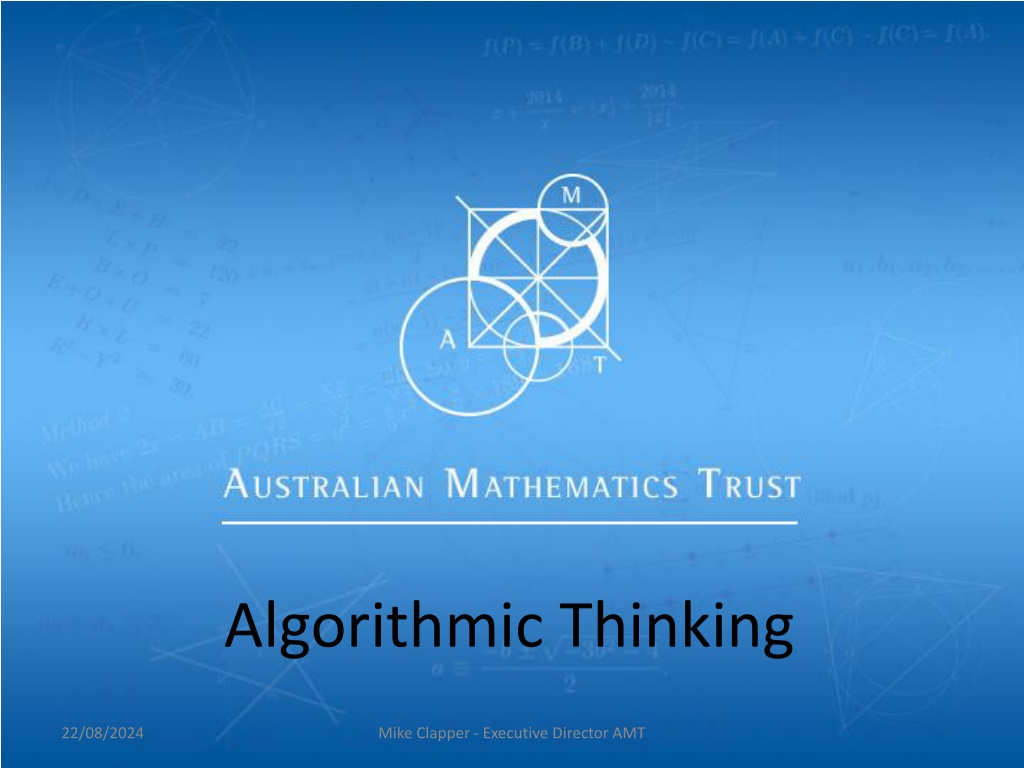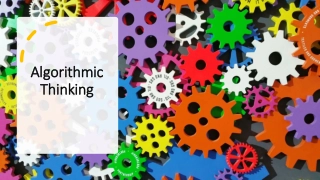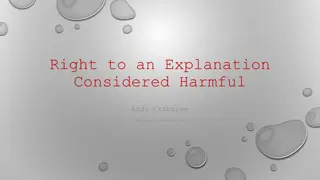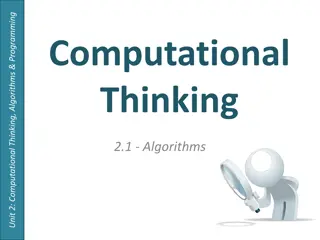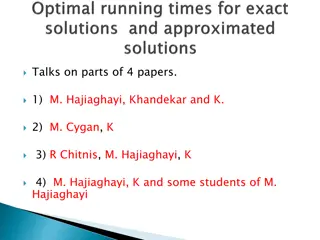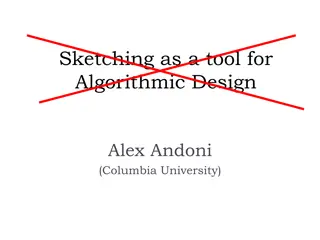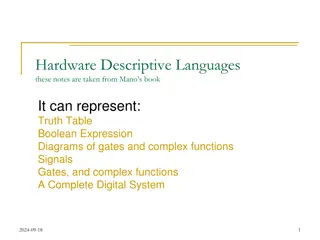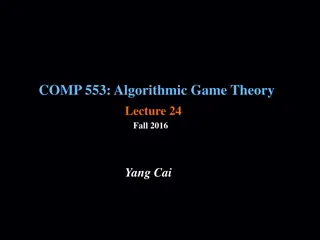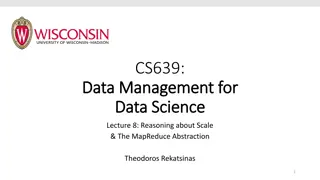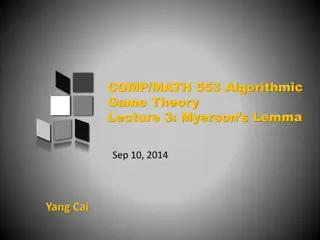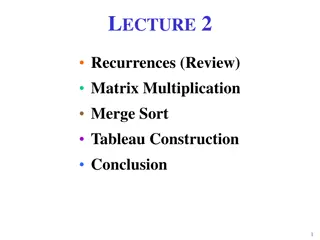Understanding Algorithmic Thinking in Digital Systems
Explore the application of algorithmic thinking in digital systems through the journey of Mike Clapper, the Executive Director of AMT. Learn about recognizing patterns in data, creating algorithms to solve problems, and utilizing information systems creatively. Enhance your knowledge of digital systems and production skills for effective data handling and presentation.
Download Presentation

Please find below an Image/Link to download the presentation.
The content on the website is provided AS IS for your information and personal use only. It may not be sold, licensed, or shared on other websites without obtaining consent from the author. Download presentation by click this link. If you encounter any issues during the download, it is possible that the publisher has removed the file from their server.
E N D
Presentation Transcript
Algorithmic Thinking 22/08/2024 Mike Clapper - Executive Director AMT
Start Count the numbers Call answer COUNT Find the sum of the numbers Call answer SUM Divide SUM by COUNT Call answer AVERAGE Print AVERAGE Stop 22/08/2024 Mike Clapper - Executive Director AMT
Start Input NUMBER and DIVISOR Set TOTAL to 0, set ANSWER to 0 Add DIVISOR to TOTAL Add 1 to ANSWER Is NUMBER bigger than TOTAL? No Yes Print ANSWER Subtract 1 from ANSWER Stop 22/08/2024 Mike Clapper - Executive Director AMT
NUMBER DIVISOR TOTAL ANSWER 20 6 0 0 22/08/2024 Mike Clapper - Executive Director AMT
Knowledge and Understanding Processes and Production Skills Recognise and explore digital systems for a purpose Collect, explore and sort data, and use digital systems to present the data creatively Recognise and explore patterns in data and represent data as pictures, symbols and diagrams Follow, describe and represent a sequence of steps and decisions (algorithms) needed to solve simple problems Explore how people safely use common information systems to meet information, communication and recreation needs Create and organise ideas and information using information systems independently and with others, and share these with known people in safe online environment Mike Clapper - Executive Director AMT 22/08/2024
Knowledge and Understanding Processes and Production Skills Identify and explore a range of digital systems with peripheral devices for different purposes, and transmit different types of data Collect, access and present different types of data using simple software to create information and solve problems Recognise different types of data and explore how the same data can be represented in different ways Define simple problems, and describe and follow a sequence of steps and decisions (algorithms) needed to solve them Implement simple digital solutions as visual programs with algorithms involving branching (decisions) and user input 22/08/2024 Mike Clapper - Executive Director AMT
Knowledge and Understanding Processes and Production Skills Create and organise ideas and information using information systems independently and with others, and share these with known people in safe online environments Plan, create and communicate ideas and information independently and with others, applying agreed ethical and social protocols 22/08/2024 Mike Clapper - Executive Director AMT
Knowledge and Understanding Processes and Production Skills Examine the main components of common digital systems and how they connect together to form networks Acquire, store and validate different types of data, and use a range of software to interpret and visualise data to create information Examine how whole numbers are used to represent all data in digital systems Define problems in terms of data and functional requirements drawing on previously solved problems Design a user interface for a digital system Design, modify and follow simple algorithms involving sequences of steps, branching and iteration (repetition) 22/08/2024 Mike Clapper - Executive Director AMT
Knowledge and Understanding Processes and Production Skills Implement digital solutions as simple visual programs involving branching, iteration, and user input Explain how student solutions and existing information systems are sustainable and meet current and future local community needs Plan, create and communicate ideas and information, including collaboratively online, applying agreed ethical, social and technical protocols Mike Clapper - Executive Director AMT 22/08/2024
Knowledge and Understanding Processes and Production Skills Investigate how data is transmitted and secured in wired, wireless and mobile networks, and how the specifications affect performance Acquire data from a range of sources and evaluate authenticity, accuracy and timeliness Investigate how digital systems represent text, image and audio data in binary Analyse and visualise data using a range of software to create information, and use structured data to model objects or events Define and decompose real-world problems taking into account functional requirements and economic, environmental, social, technical and usability constraints Design the user experience of a digital system, generating, evaluating and communicating alternative design Mike Clapper - Executive Director AMT 22/08/2024
Knowledge and Understanding Processes and Production Skills Design algorithms represented diagrammatically and in English, and trace algorithms to predict output for a given input and to identify errors Implement and modify programs with user interfaces involving branching, iteration and functions in a general- purpose programming language Evaluate how student solutions and existing information systems meet needs, are innovative, and take account of future risks and sustainability Plan and manage projects that create and communicate ideas and information collaboratively online, taking safety and social contexts into account 22/08/2024 Mike Clapper - Executive Director AMT
Knowledge and Understanding Processes and Production Skills Investigate the role of hardware and software in managing, controlling and securing the movement of and access to data in networked digital systems Develop techniques for acquiring, storing and validating quantitative and qualitative data from a range of sources, considering privacy and security requirements Analyse simple compression of data and how content data are separated from presentation Analyse and visualise data to create information and address complex problems, and model processes, entities and their relationships using structured data Define and decompose real-world problems precisely, taking into account functional and non-functional requirements and including interviewing stakeholders to identify needs Design the user experience of a digital system by evaluating alternative designs against criteria including functionality, accessibility, usability, and aesthetics Mike Clapper - Executive Director AMT 22/08/2024
Knowledge and Understanding Processes and Production Skills Design algorithms represented diagrammatically and in structured English and validate algorithms and programs through tracing and test cases Implement modular programs, applying selected algorithms and data structures including using an object-oriented programming language Evaluate critically how student solutions and existing information systems and policies, take account of future risks and sustainability and provide opportunities for innovation and enterprise Create interactive solutions for sharing ideas and information online, taking into account safety, social contexts and legal responsibilities Plan and manage projects using an iterative and collaborative approach, identifying risks and considering safety and sustainability Mike Clapper - Executive Director AMT 22/08/2024
Start Guess =1 Yes Too low? Add 1 to guess No Print Guess Stop 22/08/2024 Mike Clapper - Executive Director AMT
Incremental algorithmic design 22/08/2024 Mike Clapper - Executive Director AMT
Resources for teaching algorithmic thinking 22/08/2024 Mike Clapper - Executive Director AMT
Sample questions Junior 1 Junior 5 Senior 3 Senior 4 Hrossan Quilts Emu Frog Musca 22/08/2024 Mike Clapper - Executive Director AMT
Junior 1. Hrossan Quilts Each hexagon and the two beneath it must be the same colour (R,G or B) or different colours. How many blue patches are there in the quilt below? 22/08/2024 Mike Clapper - Executive Director AMT
Junior 1. Hrossan Quilts Each hexagon and the two beneath it must be the same colour (R,G or B) or different colours. How many blue patches are there in the quilt below? 22/08/2024 Mike Clapper - Executive Director AMT
Junior 1. Hrossan Quilts Each hexagon and the two beneath it must be the same colour (R,G or B) or different colours. How many blue patches are there in the quilt below? R 22/08/2024 Mike Clapper - Executive Director AMT
Junior 1. Hrossan Quilts Each hexagon and the two beneath it must be the same colour (R,G or B) or different colours. How many blue patches are there in the quilt below? R 22/08/2024 Mike Clapper - Executive Director AMT
Junior 1. Hrossan Quilts Each hexagon and the two beneath it must be the same colour (R,G or B) or different colours. How many blue patches are there in the quilt below? R B 22/08/2024 Mike Clapper - Executive Director AMT
Junior 1. Hrossan Quilts Each hexagon and the two beneath it must be the same colour (R,G or B) or different colours. How many blue patches are there in the quilt below? B R G R R B G R G B R R R B B 22/08/2024 Mike Clapper - Executive Director AMT
Junior 1. Hrossan Quilts Each hexagon and the two beneath it must be the same colour (R,G or B) or different colours. How many blue patches are there in the quilt below? B R G R R B G R G B R R R B B 22/08/2024 Mike Clapper - Executive Director AMT
Junior 1. Hrossan Quilts Each hexagon and the two beneath it must be the same colour (R,G or B) or different colours. How many blue patches are there in the quilt below?5 B R G R R B G R G B R R R B B 22/08/2024 Mike Clapper - Executive Director AMT
Junior 5. Emu Emus will take at most 3 steps from the nesting burrow in search of food. They refuse to walk through water or even over water. B is the location of the burrow and the shaded cells are wet. An emu can cover up to 4 cells in one step, and a step may not turn a corner. In the diagram below, in how many dry cells will the emu NOT search for food? 22/08/2024 Mike Clapper - Executive Director AMT
Junior 5. Emu Emus will take at most 3 steps from the nesting burrow in search of food. They refuse to walk through water or even over water. B is the location of the burrow and the shaded cells are wet. An emu can cover up to 4 cells in one step, and a step may not turn a corner. In the diagram below, in how many dry cells will the emu NOT search for food? 1 1 1 1 1 22/08/2024 Mike Clapper - Executive Director AMT
Junior 5. Emu Emus will take at most 3 steps from the nesting burrow in search of food. They refuse to walk through water or even over water. B is the location of the burrow and the shaded cells are wet. An emu can cover up to 4 cells in one step, and a step may not turn a corner. In the diagram below, in how many dry cells will the emu NOT search for food? 1 2 2 1 1 2 2 2 2 2 2 2 2 1 1 22/08/2024 Mike Clapper - Executive Director AMT
Junior 5. Emu Emus will take at most 3 steps from the nesting burrow in search of food. They refuse to walk through water or even over water. B is the location of the burrow and the shaded cells are wet. An emu can cover up to 4 cells in one step, and a step may not turn a corner. In the diagram below, in how many dry cells will the emu NOT search for food? 1 2 2 1 1 2 2 2 2 2 2 2 2 3 3 3 3 3 1 1 3 3 3 3 3 3 3 22/08/2024 Mike Clapper - Executive Director AMT
Junior 5. Emu Emus will take at most 3 steps from the nesting burrow in search of food. They refuse to walk through water or even over water. B is the location of the burrow and the shaded cells are wet. An emu can cover up to 4 cells in one step, and a step may not turn a corner. In the diagram below, in how many dry cells will the emu NOT search for food? 9 1 2 2 1 1 2 2 2 2 2 2 2 2 3 3 3 3 3 1 1 3 3 3 3 3 3 3 22/08/2024 Mike Clapper - Executive Director AMT
Senior 3. Frog White squares represent lily pads and grey squares represent water. A frog may jump from one lily pad to another, horizontally or vertically. It can jump over large spans of water, but it may not jump over another lily pad. Beginning on the lily pad marked F , what is the minimum number of jumps the frog needs in order to ensure that it can reach any other lily pad? 22/08/2024 Mike Clapper - Executive Director AMT
Senior 3. Frog White squares represent lily pads and grey squares represent water. A frog may jump from one lily pad to another, horizontally or vertically. It can jump over large spans of water, but it may not jump over another lily pad. Beginning on the lily pad marked F , what is the minimum number of jumps the frog needs in order to ensure that it can reach any other lily pad? 1 1 22/08/2024 Mike Clapper - Executive Director AMT
Senior 3. Frog White squares represent lily pads and grey squares represent water. A frog may jump from one lily pad to another, horizontally or vertically. It can jump over large spans of water, but it may not jump over another lily pad. Beginning on the lily pad marked F , what is the minimum number of jumps the frog needs in order to ensure that it can reach any other lily pad? 2 1 2 2 2 2 1 22/08/2024 Mike Clapper - Executive Director AMT
Senior 3. Frog White squares represent lily pads and grey squares represent water. A frog may jump from one lily pad to another, horizontally or vertically. It can jump over large spans of water, but it may not jump over another lily pad. Beginning on the lily pad marked F , what is the minimum number of jumps the frog needs in order to ensure that it can reach any other lily pad? 3 3 3 3 2 3 1 2 2 2 2 1 3 22/08/2024 Mike Clapper - Executive Director AMT
Senior 3. Frog White squares represent lily pads and grey squares represent water. A frog may jump from one lily pad to another, horizontally or vertically. It can jump over large spans of water, but it may not jump over another lily pad. Beginning on the lily pad marked F , what is the minimum number of jumps the frog needs in order to ensure that it can reach any other lily pad? 4 4 4 3 4 3 4 4 3 4 4 4 3 2 3 1 2 2 2 2 4 1 3 22/08/2024 Mike Clapper - Executive Director AMT
Senior 3. Frog White squares represent lily pads and grey squares represent water. A frog may jump from one lily pad to another, horizontally or vertically. It can jump over large spans of water, but it may not jump over another lily pad. Beginning on the lily pad marked F , what is the minimum number of jumps the frog needs in order to ensure that it can reach any other lily pad? 4 5 5 5 4 4 5 5 3 4 3 4 4 3 4 4 4 3 2 3 1 2 2 2 2 4 1 3 22/08/2024 Mike Clapper - Executive Director AMT
Senior 3. Frog White squares represent lily pads and grey squares represent water. A frog may jump from one lily pad to another, horizontally or vertically. It can jump over large spans of water, but it may not jump over another lily pad. Beginning on the lily pad marked F , what is the minimum number of jumps the frog needs in order to ensure that it can reach any other lily pad? 4 5 5 5 5 4 4 5 5 3 4 3 4 4 3 4 4 4 3 2 3 1 2 2 2 2 4 1 3 22/08/2024 Mike Clapper - Executive Director AMT
Senior 4. Musca Two players take turns to move a counter one or more cells to the left or down. The counter may not be moved onto or across a shaded cell. The winner is the player who moves the counter to the bottom left hand corner. Some cells will be winning cells for the player who goes first, and some will be losing cells. In the diagram below, how many of the cells marked are winning cells? 22/08/2024 Mike Clapper - Executive Director AMT
Senior 4. Musca Two players take turns to move a counter one or more cells to the left or down. The counter may not be moved onto or across a shaded cell. The winner is the player who moves the counter to the bottom left hand corner. Some cells will be winning cells for the player who goes first, and some will be losing cells. In the diagram below, how many of the cells marked are winning cells? W W W W W W W W W W W W 22/08/2024 Mike Clapper - Executive Director AMT
Senior 4. Musca Two players take turns to move a counter one or more cells to the left or down. The counter may not be moved onto or across a shaded cell. The winner is the player who moves the counter to the bottom left hand corner. Some cells will be winning cells for the player who goes first, and some will be losing cells. In the diagram below, how many of the cells marked are winning cells? W W W W W W L L W W W W W W 22/08/2024 Mike Clapper - Executive Director AMT
